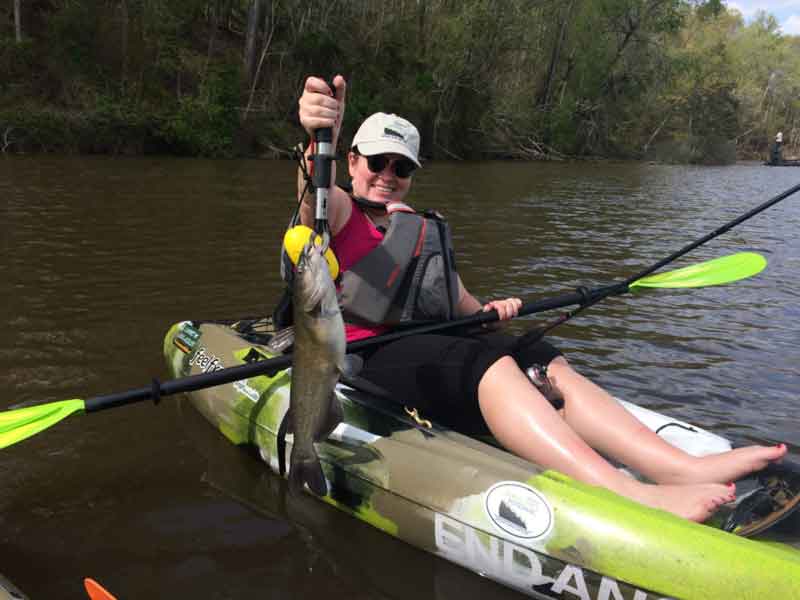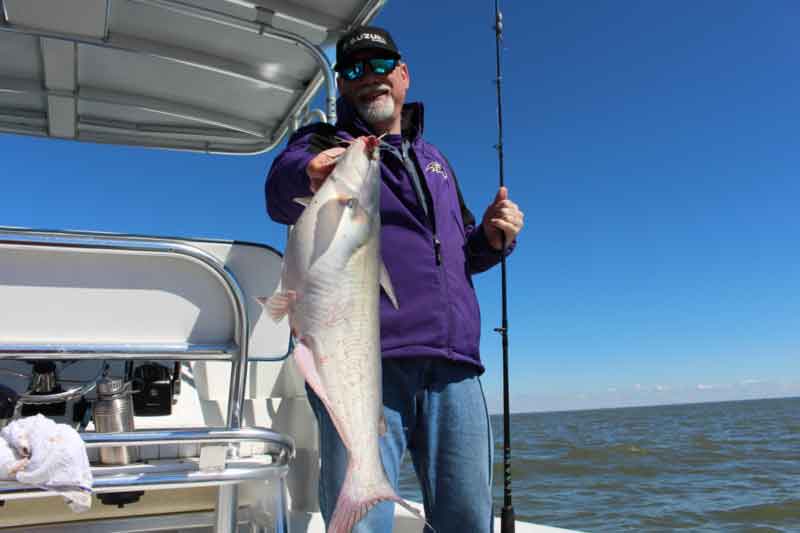More and more, when I go out fishing on the Bay or one of its tributaries I find myself setting the hook on a fish, and my rod completely stops. It gets a deep bend, then tries to escape my grasp as drag begins to peel off the reel. That's when I know I've hooked into one of my favorite fish to catch in the area: the channel catfish (Ictalurus punctatus). Whether you're fishing with a bottom rig from a pier, anchored up in a boat with cut bait on a fish finder rig, or casting a lure at rip rap, there is a high probability a channel cat is lurking nearby. Channel cats are an introduced species in Chesapeake country, and the recent years of heavy rain and low salinity in the Bay have allowed them to spread to new areas. Love them or hate them, channel cats aren't leaving any time soon.

In my opinion, there’s a lot to love about these bruisers. With the current state of striped bass in the Chesapeake, channel cats offer a wonderful alternative that can ease the strain on the rockfish population. While not as pretty as a striper (true, they have a face only a mother could love), channel cats take almost any bait or lure you throw at them, they live just about everywhere, they fight hard at any size, and on top of it all they’re very good to eat. Channel cats don’t have the muddy flavor of some catfish species and taste great grilled, blackened, fried, made into faux crab cakes, or added to a gumbo or jambalaya. Added bonus: unlike most catfish species, channel cats will readily hit artificial lures.
Tidal Catfish Tactics
As many Chesapeake Bay anglers learned this spring, about the time trophy rockfish season begins you can catch plenty of channel catfish in the Bay’s open waters when and where salinity levels are low. Bunker chunks on a chumming rig – just as bait anglers use to target the rockfish – are very effective.
Once the water temps in the Chesapeake reach 75-degrees, channel cats move up into shallow water to spawn and may remain there until late fall, choosing to hide in rocky areas, under logs and fallen trees, and under docks. If you’ve been fishing in an area for a while, you won’t need to change your tactics much to hook into a big channel cat. If you’re used to fishing for white perch with a bottom rig, upgrade your hooks to around a size 1/0 or 2/0, though in my experience they don’t take hooks bigger than 3/0 as often. The bigger hooks will prevent them from straightening, and will keep some of the smaller fish off your bait. You can use the usual baits – bloodworms, cut alewife, grass shrimp, etcetera – but a hunk of chicken liver, purchased at your local grocery for cheap, will get more channel catfish on the end of your line. Also, in the interest of keeping costs down, you can use the rib sections after filleting a mess of perch, cut into one-inch strips. You can do the same with a fish finder rig, though channel cats are not finicky about biting and the slip sinker is not a necessity.

Give the cats a different look in shallow water with a four-inch Gulp Swimming Mullet fished on a quarter-ounce jig, two to three feet under a float. Set the depth to keep the jig just off the bottom, and the current will make the tail flutter. You might even be surprised by a rockfish or a larger perch taking the bait.
Gearing Up for Channel Catfish
There’s nothing more fun than hooking into one of these big cats and going for a sleigh ride on your kayak. Sometimes they slam lures like Rat-L-Traps or Beetle Spins while you’re perch fishing with an ultralight rod and six-pound test. But to target the cats in specific I have two rigs that I like to use. The previously mentioned jig with the Gulp! Swimming Mullet, minus the float, is fantastic for fishing under docks. Using 10 to 15-pound test monofilament provides more abrasion resistance than braid, which will keep your line a little safer around pilings. Drop the jig to the bottom and slowly jig it, giving a few seconds in between movements. You will not get a big thump most of the time if a catfish bites. You’ll lift and feel a bit of weight, which is when you tighten up and slam the hook home. Get ready, because that cat is going to get mad.
Another rig for kayak fishing is a short Carolina rig, with a quarter- to half-ounce egg sinker, a barrel swivel, 12 to 18 inches of 20-pound fluorocarbon leader, and a 1/0 octopus or circle hook. Cast the rig out with some cut bait and once it hits the bottom, give it slow lifts, dropping the weight back to the bottom and reeling up the slack as it comes toward you. A bottom rig is difficult to keep in place and annoying to deal with in a kayak, so this simpler rig works well when drifting near structure.
Fishing out in the open, I recommend a seven-foot medium to medium-heavy rod. However, for a bit of fun and more maneuverability around the docks, try a shorter medium-action rod. This will allow you to control the fish, but also gives you an entertaining fight.
Everyone needs to do their part and help keep these non-native catfish in check. If you fish in Virginia, you can keep up to 20 channel cats in a day, with no minimum size. In Maryland, you can keep as many as you want without restriction. However, it’s my firm belief that we should only take what we need and not be wasteful. Go out and catch a fish that fights hard, tastes great, and provides an entire meal for the family with just one fat cat.
- By Peter Turcik